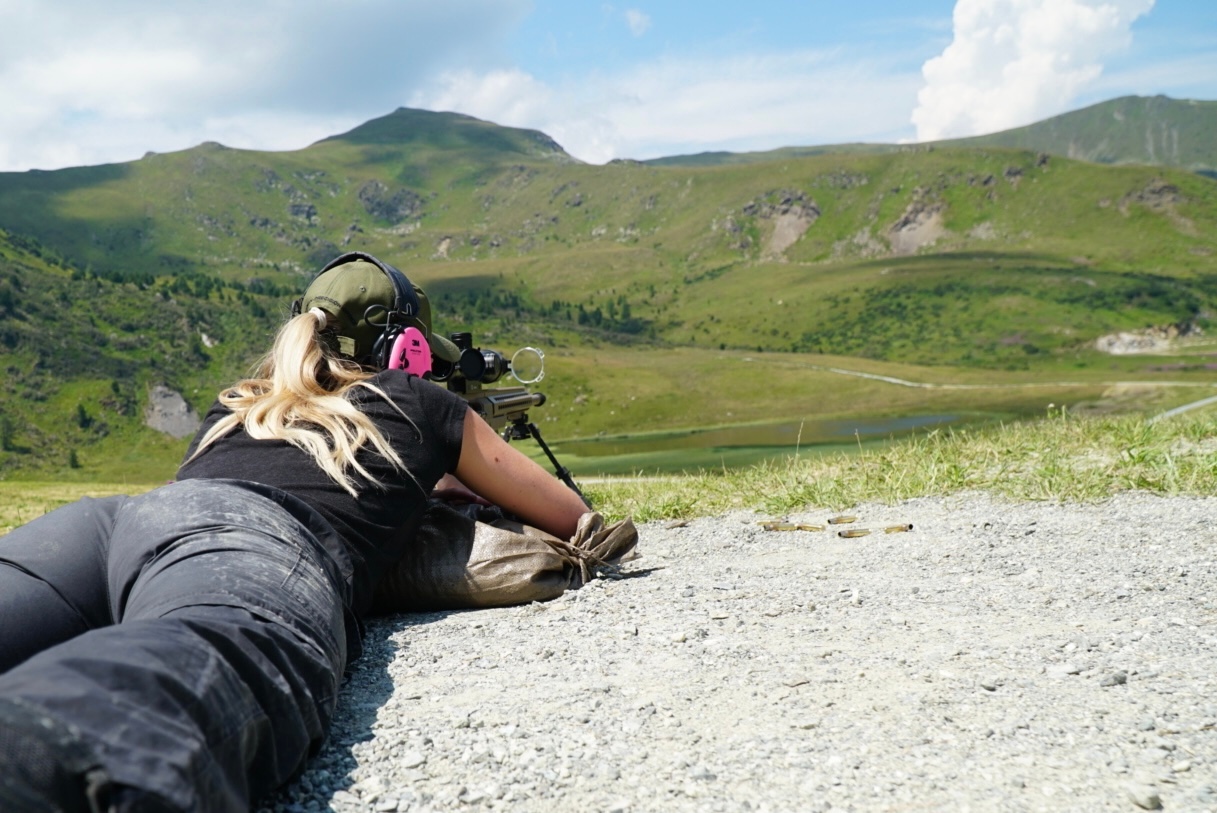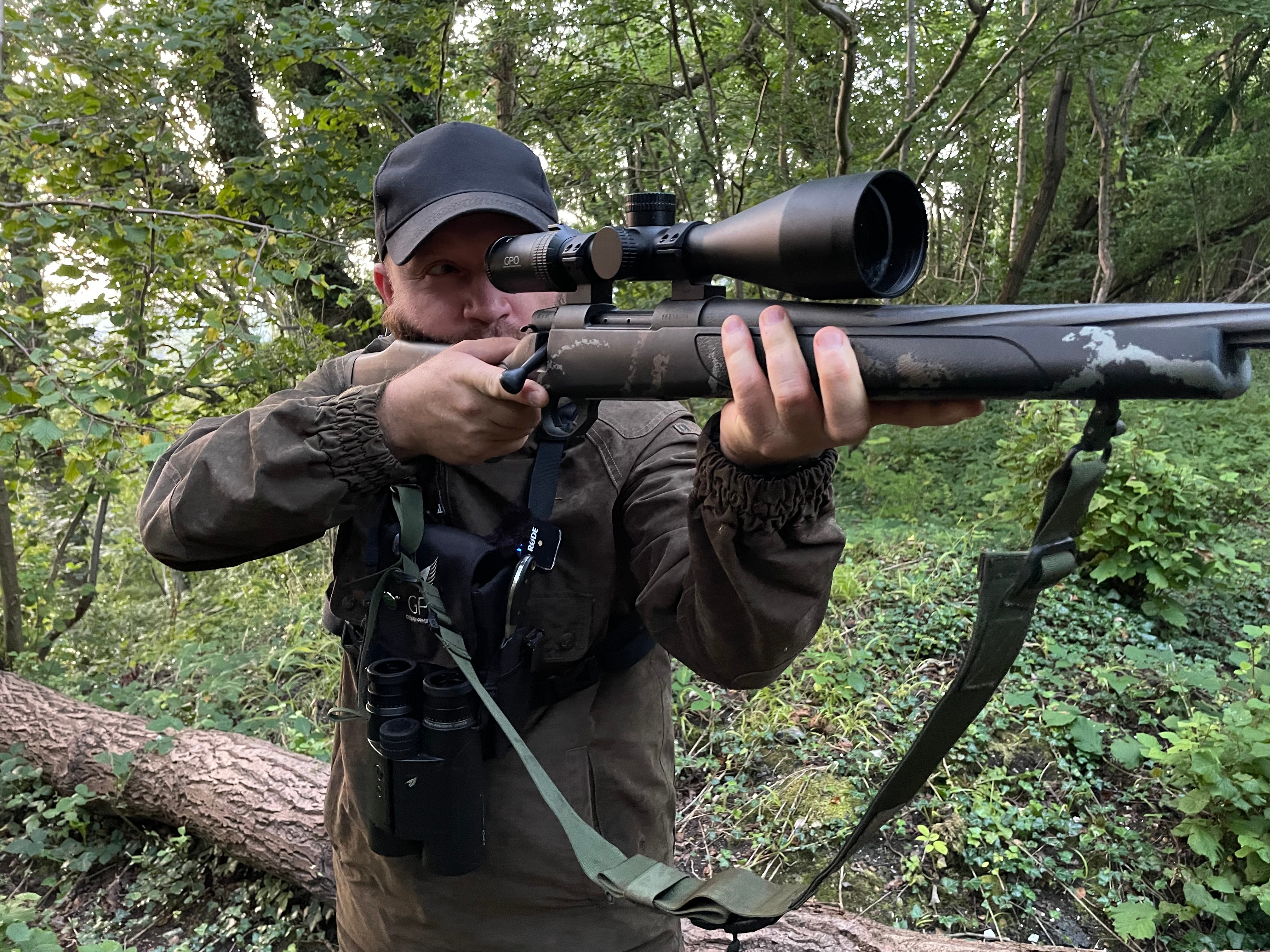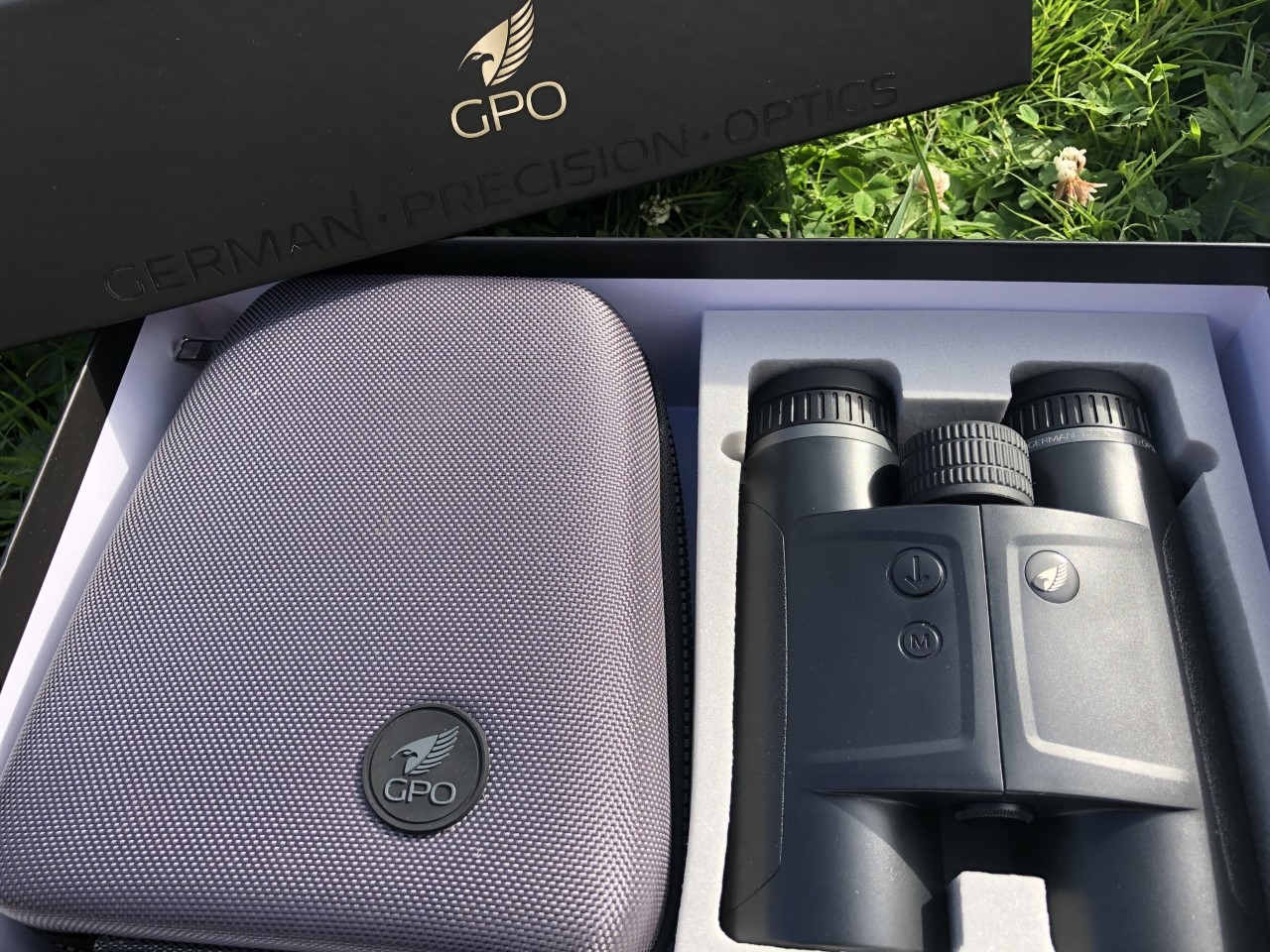We had the GPO optics combo with us for the raised hide, stalking and hunting wild boar at night, as well as on a shooting range visit. The thermal imaging device should be well suited as a handheld device as well as a thermal imaging clip-on due to its range of features, compact design and ease of use. But before we turn our attention to this device, we should first look at the optical basis: an all-rounder from the GPO range, the Spectra 6x 2-12x50i riflescope.
The compact GPO Spectra 6x 2-12x50i riflescope
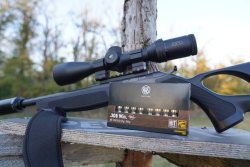
The GPO Spectra 6x riflescope model series offers a total of six models that cover all types of hunting. Starting with the Spectra 6x 1-6x24i driven hunt scope and ending with the long range specialist, the Spectra 6x 3-18x56i. Our Spectra test model accompanied us on two hunting weekends. It was used as a riflescope for the raised hide and as a stalking scope. With a light transmission of over 90%, you can hunt with the Spectra 6x 2-12x50i into twilight without any problems. Sharpness is good, at the edges the image appeared not quite as sharp as in the center, but this does not matter much. This phenomenon is well known in optics and is related to the design of optical lenses. It should be mentioned that with the edge sharpness of riflescopes, the field of view should also always be in focus, because some manufacturers make some sacrifices in the field of view in favor of the edge sharpness. This is smaller, the natural blur thus virtually disappears from the field of view. The GPO Spectra 6x 2-12x50i offers a field of view of 21 meters at 100 meters in the 2x, lowest magnification setting, and 3.5 meters at 100 meters in the highest 12x magnification. If you take a realistic magnification of the middle range, about six for aiming a shot at 100 meters, you get a field of view of almost eight meters.
Our author tells us his personal view of things when it comes to a riflescope that you want to use together with a thermal imaging device: "Before making a purchase decision, you can't avoid comparing the rifle scope from GPO with other brands and models. If one does this and looks at the technical data of corresponding riflescopes from Leica and Zeiss, one finds that the GPO Spectra 6x 2-12x50i turns into the home stretch with a price advantage of currently just under 850 euros. For that money, you get the Bergara BA13 single-shot rifle, which we used for our field test, on top of that. So, you should take a closer look at the scope from GPO, because for an MSRP of 849.99 euros, you get a lot of optics offered. As a lightweight all-round scope, it can also be used for driven hunts, as well as for raised hide. In addition, it plays by the moderate total weight of under 600 grams. Up to 200 meters, the Spectra 6x 2-12x50i riflescope can therefore be used in most hunting situations without any problems." The question remains: does it necessarily have to be a premium brand? There is certainly no generally valid answer to this, everyone must decide for themselves. But the GPO is a good choice, especially together with a clip-on, if you are willing to make minor sacrifices.
The field test: the GPO Spectra TI 35 thermal imager
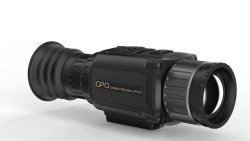
The second product in the test was the GPO Spectra TI 35, a dual-use thermal imager. It comes for an MSRP of 2,999 euros. It is powered by two CR123A batteries (included), rechargeable batteries (you have to buy them yourself) or using the included USB-C cable and powerbank. The device has a wake-up function and is quickly ready for use. According to the manufacturer, the operating time per high-quality battery/accumulator set (we used Panasonic Lithium CR123 A with 1550 mAh) is 4.5 hours, depending on the outdoor temperature. The device can identify heat sources up to 1,300 meters. However, according to our experience from the field test, a clean response is only possible in the range up to 300 meters, depending on the user's experience and the size of the sighted game. The device delivers clean and clear images as a handheld device. If it is used as a clip-on in combination with the scope, sharp images are no longer possible at 6x magnification. We therefore recommend that you carefully consider all shots that are to be taken further than 120 meters, as the risk of possible misses increases – and this does not have to be the case.
The technology of the GPO Spectra TI35 – sensor and resolution

The 17 um pixel size (pitch) in combination with the sensitivity of less than 35 mK and the detector resolution of 384 x 288 pixels is only at first glance a disadvantage compared to other models with larger sensor size and smaller pitch. As is well known, thermal imagers are always dependent on the weather and a larger pitch is often an advantage. Especially with models that have less features than the GPO Spectra TI 35, this quickly becomes apparent in the form of "haze images". This can be observed again and again, especially in humid or foggy weather conditions. We were "lucky as testers" and "unlucky as hunters" in that the weather threw a spanner in the works, at least during one of the night boar hunts. The fog showed us that the GPO Spectra TI 35 also copes well with these weather conditions. The fact that the wind was unfavorable for us should only be mentioned in passing at this point. During a second stalk in the morning, the Spectra TI 35 confirmed this advantage. We were able to spot fallow deer very well in the fog.
The GPO TI 35 thermal imager can estimate distances
First things first: the unit does not have a built-in laser rangefinder. But the advantages of the TI 35 are its compact design and the ability to "estimate" distances quite reliably with the built-in rangefinder mode. This should be a real plus, especially if you are invited to a foreign hunting ground as a guest, for example, and do not know the local conditions. If you measure the distance, the manufacturer gives an accuracy of ± 10 percent. This means that if I use the distance measuring module, I have to reckon with a fluctuation of 10 meters up and down at 100 meters. The measurement itself is quite simple. Once you have selected the measurement mode in the main menu, you can choose from four options (brown bear, deer, gray wolf, custom). The individual options are each adjustable in height. For example, if you have selected "Gray Wolf" and set the height to 80 centimeters, because you are hunting wild boar at night, you measure the distance according to the settings just mentioned as follows: first you see a thin cursor sitting over a horizontal line. Now you press the main menu button and measure – when the boar is pointing, for example – the head of the game animal. The cursor blinks twice and then jumps below the horizontal line. Now measure the second point at the height of the hoof. The cursor blinks and after a short time the measured "estimated" distance appears at the top left of the window. One must say the following about this method: ideally, the object stands still, then the "estimate" becomes more accurate. If you have enough time for hunting, you can repeat this measurement a few times to be sure how far away game is. The "distance estimator" is a real help, although not yet 100% mature. Unlike other products, the Spectra TI 35 at least has the ability to realistically estimate the distance. What bothered us a bit was that after each measurement, you always start from the beginning to take the next measurement. So you always have to start again in the main menu to perform the next "range estimate".
This is certainly a small minus point in cases where speed is required. However, if you have enough time, for example on the hunt, this is not a problem.
The GPO thermal imaging attachment in practical use

Before we went hunting with the device for the first time, we zeroed it in at the shooting range with the Bergara BA13 single-shot rifle in .308 caliber. We used the HIT Short Rifle with 9.7g from RWS as ammunition. The manufacturer recommends rough zeroing in at 50 meters with a later check shot at 100 meters. We started immediately at 100 meters. When zeroing in the rifle, it may happen that you have to adjust the point of impact. This is also quite simple to do. Choose a firm, secure rest, attach the heat pad to a target and place the first shot. During the first shot, you should play through the different color palettes of the device. In this way, you can select the option with the highest contrast and imaging performance. The shooting itself should take place in the smallest possible magnification, so that the sharpness in the target is still sufficient. We have found that with the combination of a riflescope and a thermal imaging attachment, it is possible to zoom up to a maximum of 6x. Already in the range of 4-6x the image becomes blurred, which is why we can recommend – from a hunting point of view – that a shot be taken up to 120 meters with this combination. Anything beyond that increases the risk of a missed shot. The blurriness in the image at magnifications of 6x and more makes it difficult to realistically assess the behavior of wild animals. This should be taken into account and, if in doubt, it is better to leave the finger straight. It is advisable to use the "Live-View" of the TI35 in full format on the smartphone or tablet by means of the "T-Vision" smartphone app and via hot-spot / W-Lan function when using a scope with 3x or higher output magnification. Make sure that the adapters, extension rings and scope are securely and correctly seated. If you get stuck, download the manufacturer's instructions and read them carefully. When you have placed the first shot, see where the hit is.
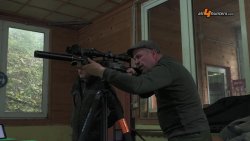
In our case, the first hit was so well placed that we only had to make a minimal correction, and that was in the X axis. The first shot sat a bit far to the right. With one click to the left, the correction was made. Per click, whether to "Right", "Left", "Up" or "Down" – you shift the point of impact at 50 meters by 1.25 centimeters. If you shoot at 100 meters, it is 2.5 centimeters per click. Important to know. The Spectra TI 35 automatically detects whether you are using it as a handheld scope for observing or as a clip-on for hunting. Once the adapter ring is installed for mounting on a scope, you can adjust the X and Y axes. If you use the GPO Spectra TI 35 as a hand-held device, you cannot adjust the X and Y axes. You will not find the menu for setting the X and Y axes in the main menu. To set the X and Y axes, both the "Up" and "Down" keys of the main menu key must be pressed simultaneously. A new window opens and if you use the live view function with a smartphone or tablet, you will see the values for X and Y in the window on the left. With the "Right" and "Left" buttons located next to the main menu button you change the X-axis, with the "Up" and "Down" buttons placed above the main menu button you change the Y-axis. The values are retained even when the device is switched off or reset to the factory settings. Be sure to make a note of the values for your gun combination. If you then reset the "Image Calibration" and restore the "Standard", you will have to re-zero the gun.
Why a video function in the thermal imaging device?
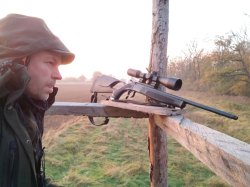
Especially when shooting at night, missed shots are fatal, because the shot game can often only be searched for the next day. It does not matter whether the miss was made in the field or in the forest. A missed shot remains a missed shot. When hunting at night in forest areas, the visibility is more limited than in a typical field area. Branches, trees and bushes can severely restrict visibility. If the weather is also unfavorable, thermal imaging technology quickly reaches its limits. In addition, without a rangefinder, it is very difficult to determine distances and almost impossible to do so without knowledge of the territory. You should also be familiar with the behavior of raccoons, mice, rats, deer and wild boar and, above all, know how to assess the movement characteristics of wild animals. Why do we say this? Simply for the reason that before releasing the shot, it must be clear what you have in front of you. If you decide to take the shot, you should have answered the following questions beforehand:
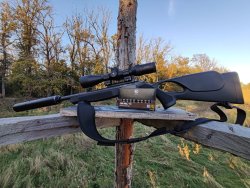
- Do I know what is in front of me? If so, go ahead and ask yourself a second time. There must be that much time.
- How far away is it from me?
- Do I have a clear view? Tracing the focus helps to see even the smallest branches.
- Do I have a second shot ready quickly? Is my aim safe?
- Do I have an elevated vantage point, do I have safe bullet trapping?
- Did I press the video recording function on the thermal imaging attachment before firing?
The video recording function on the thermal imaging attachment is not only very important as a reminder function of hunting experiences, it is also increasingly being used for post-shot analysis. In this specific case, our cameraman Matze Haack was able to kill a 100-kg boar at about 20 meters. Since the action was filmed, the shooter could immediately show the hunting guide the spot where the boar died. The animal was lying 10 meters from the point it had been hit. However, if the animal had gone farther and gotten out of sight, the hit and direction could have been analyzed from the recorded video. This would have been valuable information for a possible follow-up search. By the way, Matze had shot with the Bergara BA13 single-shot rifle in .308 caliber. Still holding the 9.7-g RWS HIT Short Rifle between his index and middle finger ready for the second shot, a clean hit in the heart put down the 100 kilo boar.
Our test conclusion on theGPO Spectra TI 35 thermal imager & Spectra 6x 2-12x50i riflescope combo
As mentioned at the beginning, both products offer plenty of performance. The riflescope impresses with a very good price-performance ratio, the GPO Spectra TI 35 thermal imager scores especially with its extensive features. A total of seven color and six ambient filters are available for selection. In addition, the final tip from the editors: use the different color palettes when zeroing in and find there the right mode that comes closest to your personal viewing experience. Either way, though, you can have a lot of hunting fun with the optics combo we tested from GPO!
What we liked: | What we liked less: |
GPO Spectra TI 35 | |
Many functions incl. video recording | Somewhat complicated operation for distance estimate |
| Image
quality convinced us | |
| Coherent
price/performance ratio | |
GPO Spectra 6x 2-12x50i | |
| Universal
use, compact and light | |
| Optically
high quality | |
| Very good
price/performance ratio | |
For more information about the products of German Precision Optics please visit the GPO website.



